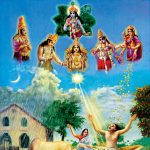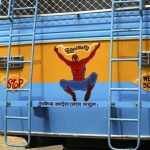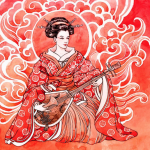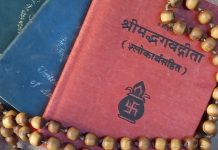I always wondered how the families of Rupa and Sanatana Gosvamis, who were Gauda Sarasvata Brahmanas from Karnataka ended up in Bengal. This article from Banglapedia explains the mystery:
"Sena Dynasty ruled Bengal for little over a century (c 1097-1225).The emergence of the dynasty, who supplanted the Palas in Bengal towards the close of the 11th century AD, is a very important chapter in the history of ancient Bengal. Taking advantage of the revolt of the Samantachakra in the varendra during the reign of Mahipala II, vijayasena, the founder of the Sena dynasty, gradually consolidated his position in Western Bengal and ultimately assumed an independent position during the reign of Madanapala. One important aspect of Sena rule in Bengal is that the whole of Bengal was brought under a single rule for the first time in its history.
The Senas originally belonged to the Karnata country (Karnatadeshatagata) in South India, the Kanarese speaking region in modern Mysore, Karnataka and Andhra Pradesh of India, and they were Brahma-Ksatriyas (those who were Brahmanas first and became Ksatriyas afterwards).
It is recorded in the Deopara Inscription of Vijayasena that Virasena and others, born in the family of the moon, were rulers of southern region and in that Sena family was born Samantasena whose descendants ruled in Bengal. It is very difficult to conclude satisfactorily as to when the Senas came and assumed power in Bengal. The Deopara Inscription records that Samantasena, the head-garland of the Brahma-Ksatriyas proceeded towards Rameshvara-Setubandha and subdued the wicked despoilers of the Laksmi (Wealth) of Karnata. But in his last days he settled down on the bank of the Ganges. From this reference it is clear that Samantasena spent his early life in the Karnata country where he certainly held some power. He, however, came to Bengal in his old age and lived somewhere near the Ganges. The Naihati copper plate of the time of vallalasena, refers to the settlement of the Sena family in western Bengal before Samantasena was born. Samantasena's descendants established the rule of the dynasty afterwards.
It is impossible to give a definite answer to the question as to how the family came to Bengal. The Sena records are silent on this question. It has been suggested that the Senas came to Bengal from Karnata and were employed in high offices like generals under the Palas. When the Pala power became weak they usurped the royal power in Bengal. The phrase Gauda-Malava-Khasa-Huna-Kulika-Karnata-Lata-Chata-Bhata occurs regularly in the Pala inscriptions, which refers to the area from where the empire drew its recruits into various services. It may be that a Karnata official in the service of the Pala empire gradually acquired power to set up an independent position. Scholars have also suggested that the ancestors of the Senas came to Bengal along with some invader form the Deccan. At first they established themselves as vassal lords and gradually founded an independent kingdom in West Bengal.
Very little is known regarding Samantasena, the first historical figure of the Sena dynasty. He, as noted earlier, had settled in his old age on the banks of the Ganges, evidently in some parts of radha. No royal title is, however, ascribed to him. His son and successor Hemantasena seems to have been a ruling chief. The disruption of the Pala kingdom following the revolt of the Samantas probably offered him an opportunity to carve out an independent principality in Radha. No record belonging to Hemantasena has yet been discovered but he is attributed the title of Maharajadhiraja in one of the Sena records. He is also described as rajaraksasudaksah (skilful in the protection of kings) in the Barrackpur plate of Vijayasena. From the above title it can be deduced that Hemantasena held the position of a feudatory chief in the Pala empire and extended his support for the protection of his overlord. There is no evidence regarding the exact dates of Samantasena and Hemantasena. However, they can be placed in the second half of the 11th century AD.
Vijayasena, son of Hemantasena, laid the foundation of the independent rule of the Senas. It appears from his records that he inherited the position of a subordinate ruler under the Palas in the Radha area. Among the fourteen Samanta kings who helped ramapala in his recovery of Varendra, there was one known as Vijayaraja of Nidravali. He was perhaps identical with Vijayasena.
Vijayasena, however, made full use of the weakness of the Pala rule in Bengal. He obtained an independent position in Radha in recognition of his help to Ramapala who fought against the Kaivartas. He defeated the Palas and captured the throne of Gauda afterwards. His queen Vilasadevi was a princess of the Shura dynasty. The existence of the Sura family in Southern Radha in the first quarter of the 11th century is attested to by the ramacharitam of Sandhyakaranandi. The same source, however, records the name of Laksmishura in the list of the vassal chiefs of Ramapala as the lord of the Apara-Mandara, identified with Mandaran in the Hooghly district. Vijaysena's matrimonial relation with the Shura family enabled him to establish his political power over Radha. He might have entered into an alliance with the Orissan king Anantavarman Codaganga. This alliance certainly enhanced his political importance. He is described as Chodaganga-Sakha (friend of Chodaganga) in the Vallalacharita of Anandabhatta.
It is beyond any doubt that Vijayasena established independent power in Bengal immediately after the demise of Ramapala. The lord of gauda who fled before Vijayasena was certainly Madanapala, the last known Pala king whose authority was, at that time, confined to North Bengal. It is learnt from the Pala epigraphic records that Madanapala's authority over North Bengal continued up to 8th year of his reign which falls in 1152-53 AD. Most Probably Vijayasena established his own supremacy in North and North Western Bengal through ousting the Palas sometime after 1152-53 AD. Vijayasena is also recorded to have extended his hold over Bihar in the west and vanga (southeastern Bengal) in the east. His Barrackpur copper plate was issued from vikramapura the capital of the Varmanas who are found to have ruled in this area from the last quarter of the 11th century to the middle of the 12th century AD. So it seems probable that Vijayasena ousted the Varmans in the middle of the 12th century AD.
Thus by the middle of the 12th century AD Vijayasena supplanted the Varmans, ousted the Palas and succeeded in establishing the rule of his own dynasty over the whole of Bengal. He had a very long reign of abort 62 years (c 1098-1160 AD). He was a Saiva and was liberal towards Brahmanas versed in the Vedas and the poor. Vijayasena assumed the imperial titles of Paramamaheshvara Paramabhattaraka Maharajadhiraja. He also took the proud epithet Ariraja-Vrsabha-Shankara. It has been suggested on good grounds that Gaud-Ovisa-Kula-prashasti (eulogy of the royal family of the Gauda) and the Vijaya-prashasti (eulogy of Vijaya) of the famous poet Sriharsa were inspired by the career of Vijayasena.
Vijayasena was succeeded by his son Vallalasena. The two epigraphs of the time of Vallalasena (The Naihati copperplate and the Sanokhar Image Inscription) have been discovered so far. They do not contain any record of his victory. He, however, had some military achievements to his credit. It is stated in the Adbhutasagara that he was engaged in warfare with the king of Gauda who is identified with Govindapala of the Pala dynasty. This information is also corroborated by the Vallalachairta of Anandabhatta composed in 1510 AD. It is learnt from various sources that Govindapala, the last Pala ruler of Magadha, lost his kingdom in 1160 AD. It is evident from the epigraphic records that this date falls in the reign of Vallalasena. Hence the final blow to the Palas in Magadha may be ascribed to him. It is stated in the Adbhutasagara that during the lifetime of his father, Vallalasena conquered Mithila.
Vallalasena's name is connected with the introduction of the practice of kulinism in Bengal. It is believed that Vallalasena with a view to reorganising the social system introduced the system of Kulinism. Through this system the ranks were bestowed upon a very few in consideration of their sort of nobility in the society known as Kulina. The basis of knowledge regarding the early history of Kulinism is the texts known as Kulagranthas or Kulajisastras. Indeed these texts, composed five or six centuries after Vallalasena's reign, are full of irregularities and contain many conflicting ideas. So the authenticity of the information furnished by the texts can be questioned. Moreover none of the Sena epigraphic records refer to Kulinism. It is known that Kulinism was the strongest force among the Bengali Brahmins in the 18th and 19th centuries AD. Hence it is quite probable that the advocates of Kulinism tried to give a historical basis to it and claimed its origin from the time of the Hindu King, Vallalasena.
It is evident from the Sena epigraphs and tradition that Vallalasena was a great scholar and renowned author. He wrote the Danasagara in 1168 and started writing the Adbhutasagara in 1169 but could not complete it. Like his father, he was also a worshipper of Shiva. He assumed the epithet Ariraja-Nihshanka-Shankara along with other imperial titles. It is learnt from the Adbhutasagara that in his old age Vallalasena left the responsibility of his government to his son laksmanasena. He and his wife spent their last days on the bank of the Ganges at a locality near Triveni. He had a successful reign of about 18 years (c 1160-78 AD).
Laksmanasena succeeded his father Vallalasena. It is evident from the records of his reign that before he came to power he defeated the king of Gauda and Varanasi (Kasi) and made expeditions against Kamarupa and Kalinga. It is quite probable that the above victories were achieved by Laksmanasena in his youth and possibly during the reign of his grand father, Vijayasena, who was engaged in warfare against the kings of Gauda, Kalinga, Kamarupa and also most probably against the King of Kasi of the Gahadaval dynasty. It appears from the epigraphs of Laksmanasena that he was the first king among the Senas to assume the title of Gaudeshvara. This title is, however, absent in the plates of both Vijayasena and Vallalasena.
There is no doubt that Laksmanasena came to the throne at a fairly old age. His reign was famous for remarkable literary activities. He himself wrote many Sanskrit poems and completed the Adbhutasagara, which was started by his father. His court was an assembly of several renowned poets like Jayadeva, the author of Gitagovinda; Sharana; Dhoyi, the composer of Pavanduta and probably also Govardhana. His friend Shridharadasa, son of Vatudasa, compiled the saduktikarnamrta, an anthology of the Sanskrit verses during his reign. His Chief Minister and Chief Judge was Halayudha Mishra, who wrote the Brahmanasarvasva. Umapatidhara, the author of the Deopara Prashasti, is referred to have been the minister and one of the several court poets of Laksmanasena.
It is well known that Laksmanasena was a staunch Vaisnava. He took the title of Paramavaisnava or Paramanarasimha. Nothing definite is known regarding his change of faith. Laksmanasena was famous for his exceptional qualities and proverbial generosity. Indeed his generosity even attracted the attention of Minhaj-us-Siraj, the author of the tabaqat-i-nasiri, who designated him as a "great Rae" of Bengal and compared him with Sultan Qutbuddin. Laksmanasena, however, became too weak to run the administration of his empire towards the close of his reign. During this time there were signs of disruption and disintegration within his empire. Contemporary epigraphic records refer to the emergence of a number of independent chiefs in different parts of the Sena kingdom, which broke its solidarity and paved the way of its decline. However, Muhammad bakhtiyar khalji, gave the final blow to the Sena kingdom (1204 AD). Laksmanasena's presence in southeastern Bengal is, however, proved by the epigraphic records. After the death of Laksmanasena in 1206 AD, his two sons Vishvarupasena and Keshavasena occupied the throne one after the other. No detailed account of their reign is available. It is evident from the epigraphic records that southern and eastern parts of Bengal were under their domination for a period of nearly twenty-five years. The plates of Vishvarupasena and Keshavasena granted lands in the Vikramapura and Vanga areas which bears clear testimony to their authority in that area after the death of their father. It is learnt from Tabaqat-i-Nasiri that the descendants of Laksmanasena ruled in Vanga at least upto 1245 AD. But there is no evidence that the Senas ruled Bengal after Keshavasena. In a Buddhist work, Pancharaksa, the name of one Madhusena, who is given the title Gaudeshvara is preserved. He was the last known ruler of Bengal with the name-ending Sena. However, in the third quarter of the 13th century AD, the Devas supplanted the Senas from their hold over Vikramapura. By the end of the century whole of Bengal came under the control of the Muslims.
The rule of the Senas in Bengal is usually connected with the emergence of orthodox Hinduism in a Hindu-Buddhist society which for long had enjoyed the peaceful coexistence of the two religions resulting in an atmosphere of amalgam of the two. The onslaught on the Buddhists in Bengal is believed to have started in this period, which resulted in large scale Buddhist migration to the neighbouring countries. The Sena period witnessed the development of Sanskrit literature. Vallalasena and Laksmanasena were royal authors of Sanskrit texts, Danasagara and Adbhutasagara. Jayadeva, Umapatidhara, Sharana, Dhoyi, Shridharadasa, Halayudha Mishra and Govardhana were literary luminaries of the period. Sculptural art developed under the patronage of the Sena kings and courtiers. [AM Chowdhury]"











